Initial In-Flight Spectral Calibration of the Near-Infrared Spectra Acquired by the MarSCoDe Onboard the Zhurong Rover
Abstract
:1. Introduction
2. Materials and Methods
2.1. MarSCoDe SWIR Data
2.2. Positional Analysis
2.3. Spectral Calibration Methods
3. Results and Discussion
4. Conclusions
- Based on the obtained calibration panel data for 15 sols, using the observation angle and Mars rover attitude, we calculated the actual solar incidence angle and azimuth angle corresponding to each, and from the Mars rover mechanical design, we analyzed and obtained the reasons for the bad quality of the data. As the Mars rover continues to make science target observations, it should avoid the following two scenarios: the overall attitude of the rover causes the calibration panel to reach an actual solar incidence angle greater than 60° and a scenario where the incident light shines in front of the right side of the rover (azimuth about −150° to −45°). We can prevent all cases of shadow covering and low incident energy owing to the attitude if we avoid both cases. This is the key to determining the REFF quantitatively.
- To determine the sensitivity of the AOTF of the SWIR to the ambient temperature change, resulting in a wavelength offset, a spectral calibration of the central wavelength offset of the AOTF with temperature change was performed based on the spectral calibration of hyperspectral data for the absorption characteristics of the Martian atmosphere, using screened SWIR data. The results show the quantitative linear relationship of the central wavelength offset (−8 nm, −2 nm) between 0° and 40° with the AOTF temperature change. The RADF and REFF results for the calculated scientific targets show further correction of the reflectance after wavelength correction. In particular, the erroneous absorption properties of the RADF near 2300 nm and the conspicuous burrs of the REFF near 2000 nm can help us to better identify Martian minerals. An important basis for subsequent data analysis and applications has thus been provided.
Author Contributions
Funding
Data Availability Statement
Conflicts of Interest
References
- Zou, Y.; Zhu, Y.; Bai, Y.; Wang, L.; Jia, Y.; Shen, W.; Fan, Y.; Liu, Y.; Wang, C.; Zhang, A.; et al. Scientific objectives and payloads of Tianwen-1, China’s first Mars exploration mission. Adv. Space Res. 2020, 67, 812–823. [Google Scholar] [CrossRef]
- Liu, J.; Li, C.; Zhang, R.; Rao, W.; Cui, X.; Geng, Y.; Jia, Y.; Huang, H.; Ren, X.; Yan, W.; et al. Geomorphic contexts and science focus of the Zhurong landing site on Mars. Nat. Astron. 2022, 6, 65–71. [Google Scholar] [CrossRef]
- Xu, W.; Liu, X.; Yan, Z.; Li, L.; Zhang, Z.; Kuang, Y.; Jiang, H.; Yu, H.; Yang, F.; Liu, C.; et al. The MarSCoDe Instrument Suite on the Mars Rover of China’s Tianwen-1 Mission. Space Sci. Rev. 2021, 217, 64. [Google Scholar] [CrossRef]
- Royer, C.; Fouchet, T.; Montmessin, F.; Poulet, F.; Forni, O.; Johnson, J.; Gasnault, O.; Quantin-Nataf, C.; Beck, P.; Ollila, A.; et al. The flight radiometric calibration of IRS/SuperCam onboard Perseverance: Campaign follow up and performance assessment. In Proceedings of the European Planetary Science Congress, Online, 13–24 September 2021. EPSC2021-735. [Google Scholar]
- Trost, B.M.; Bogdanowicz, M.J. New synthetic reactions. Geminal alkylation. J. Am. Chem. Soc. 1973, 95, 395–406. [Google Scholar] [CrossRef]
- Mantsevich, S.N.; Korablev, O.I.; Kalinnikov, Y.K.; Ivanov, A.Y.; Kiselev, A.V. Wide-aperture TeO₂ AOTF at low temperatures: Operation and survival. Ultrasonics 2015, 59, 50–58. [Google Scholar] [CrossRef] [PubMed]
- Lv, G.; Li, J.; Li, C.; Jin, J.; Lin, Y.; Xu, R.; He, Z. Temperature Correction and Result Evaluation of Lunar Mineralogical Spectrometer for Chang’E-5 Mission. IEEE Trans. Geosci. Remote Sens. 2022, 60, 1–8. [Google Scholar] [CrossRef]
- He, Z.; Li, J.; Li, C.; Xu, R. Measurement and Correction Model for Temperature Dependence of an Acousto-Optic Tunable Filter (AOTF) Infrared Spectrometer for Lunar Surface Detection. Appl. Spectrosc. 2019, 74, 81–87. [Google Scholar] [CrossRef]
- Royer, C.; Fouchet, T.; Montmessin, F.; Poulet, F.; Forni, O.; Johnson, J.R.; Gasnault, O.; Mandon, L.; Quantin-Nataf, C.; Beck, P.; et al. The Detection of Spectral Signatures with IRS/SuperCam, Perseverance Rover: Instrument Performance. LPI Contrib. 2022, 2678, 1840. [Google Scholar]
- Goetz, A.; Heidebrecht, K.; Chrien, T. High accuracy in -flight wavelength calibration of imaging spectrometry data. In Proceedings of the Summaries of the Fifth Annual JPL Airborne Earth Science Workshop, Pasadena, CA, USA, 23–26 January 1995. [Google Scholar]
- Barry, P.S.; Shepanski, J.; Segal, C. On-orbit spectral calibration verification of Hyperion. In Proceedings of the Geoscience and Remote Sensing Symposium, Sydney, NSW, Australia, 9–13 July 2001; Volume 6, pp. 2535–2537. [Google Scholar]
- Gao, B.C.; Montes, M.J.; Davis, C.O. A curve-fitting technique to improve wavelength calibrations of imaging spectrometer data. In Proceedings of the 11th JPL Airborne Earth Science, Pasadena, CA, USA, 5–8 March 2001; pp. 99–105. [Google Scholar]
- Gao, B.C.; Montes, M.J.; Davis, C.O. Refinement of wavelength calibrations of hyperspectral imaging data using a spectrum-matching technique. Remote Sens. Environ. 2004, 90, 424–433. [Google Scholar] [CrossRef]
- Dadon, A.; Ben-dor, E.; Karnieli, A. Use of derivative calculations and minimum noise fraction transform for detecting and correcting the spectral curvature effect (smile) in Hyperion images. IEEE Trans. Geosci. Remote Sens. 2010, 48, 2603–2612. [Google Scholar] [CrossRef]
- Green, R.O.; Pavri, B.E.; Chrien, T.G. On-orbit radiometric and spectral calibration characteristics of EO-1 Hyperion derived with an underflight of AVIRIS and in situ measurements at Salar de Arizaro, Argentina. Geosci. Remote Sens. IEEE Trans. 2003, 41, 1194–1203. [Google Scholar] [CrossRef]
- Lei, Y.; Zhiyang, G.; Hongying, Z.; Chen, W.; Yin, Z.-Y.; Duan, Y.-N. In-flight spectral calibration of UAV hyperspectral imager based on Radiance Matching. J. Infrared Millim. Waves 2013, 31, 517–522. (In Chinese) [Google Scholar]
- Liu, Y.; Wang, T.; Ma, L.; Wang, N. Spectral calibration of hyperspectral data observed from a hyperspectrometer loaded on an unmanned aerial vehicle platform. IEEE J. Sel. Top. Appl. Earth Obs. Remote Sens. 2014, 7, 2630–2638. [Google Scholar] [CrossRef]
- Gao, H.L.; Gu, X.F.; Tao, Y.U.; Yong, X.I.E.; Yuan, S.U.N.; Zheng, F.J. In-flight spectral calibration of oxygen absorption channels of hyperspectral sensor. Acta Photonica Sin. 2014, 43, 58–65. (In Chinese) [Google Scholar]
- Chen, H.; Zhang, L.; Li, X.; Si, X.; Yang, B.; Zhu, X. Hyperspectral sensor in flight spectral calibration based on characteristic spectra of atmosphere. Acta Opatica Sin. 2013, 33, 287–293. (In Chinese) [Google Scholar]
- Xie, F.; Liu, C.; Shao, H.; Zhang, C.; Yang, G.; Wang, J. Scene based spectral calibration of thermal infrared hyperspectral data. Infrared Laser Eng. 2017, 46, 23–28. (In Chinese) [Google Scholar]
- Brazile, J.; Neville, R.A.; Staenz, K.; Schläpfer, D.; Sun, L.; Itten, K.I. Toward scene-based retrieval of spectral response functions for hyperspectral imagers using Fraunhofer features. Can. J. Remote Sens. 2008, 34, 43–58. [Google Scholar] [CrossRef]
- Guanter, L.; Richter, R.; Moreno, J. Spectral calibration of hyperspectral imagery using atmospheric absorption features. Appl. Opt. 2006, 45, 2360–2370. [Google Scholar] [CrossRef] [Green Version]
- Guanter, L.; Segl, K.; Sang, B.; Alonso, L.; Kaufmann, H.; Moreno, J. Scene -based spectral calibration assessment of high spectral resolution imaging spectrometers. Opt. Express 2009, 17, 11594–11606. [Google Scholar] [CrossRef] [Green Version]
- Shu, R.; Xu, W.; Liu, X.; Zhang, Z.; Yang, F.; Xu, R.; NI, S.; Ruan, Y.; Chen, J. Ground calibration and validation of laser-induced breakdown spectroscopy for the Mars surface composition detector. Sci. Sin-Phys. Mech. Astron. 2022, 52, 239506. [Google Scholar] [CrossRef]
- Franz, H.B.; Trainer, M.G.; Malespin, C.A.; Mahaffy, P.R.; Atreya, S.K.; Becker, R.H.; Benna, M.; Conrad, P.G.; Eigenbrode, J.L.; Freissinet, C.; et al. Initial SAM calibration gas experiments on Mars: Quadrupole mass spectrometer results and implications. Planet. Space Sci. 2017, 138, 44–54. [Google Scholar] [CrossRef]
- Felde, G.W.; Anderson, G.P.; Cooley, T.W.; Matthew, M.W.; Berk, A.; Lee, J. Analysis of Hyperion data with the FLAASH atmospheric correction algorithm. In Proceedings of the Geoscience and Remote Sensing Symposium, Toulouse, France, 21–25 July 2003; Volume 1, pp. 90–92. [Google Scholar]
- Seiler, M.C.; Seiler, F.A. Numerical recipes in C: The art of scientific computing. Risk Anal. 1989, 9, 415–416. [Google Scholar] [CrossRef]
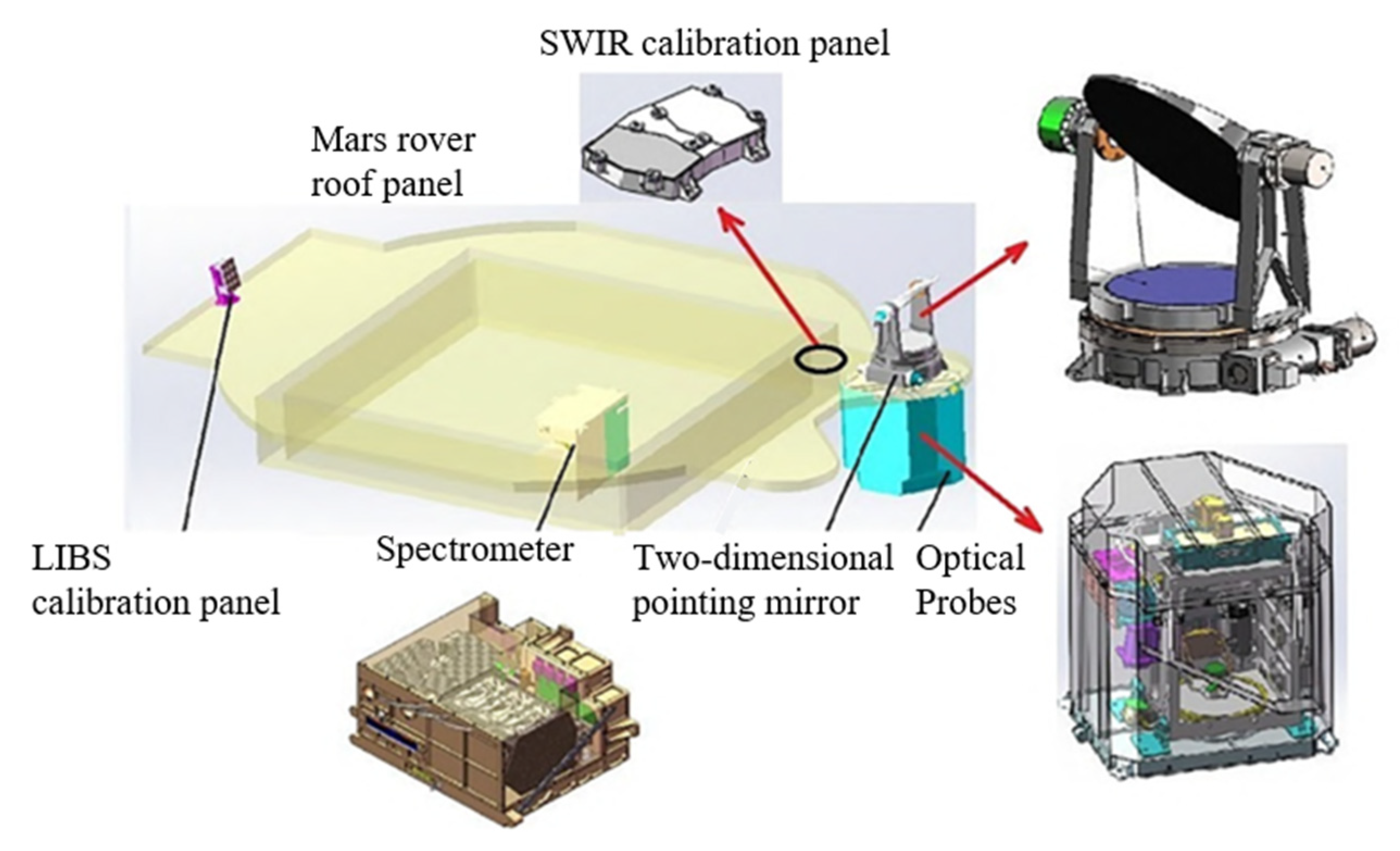
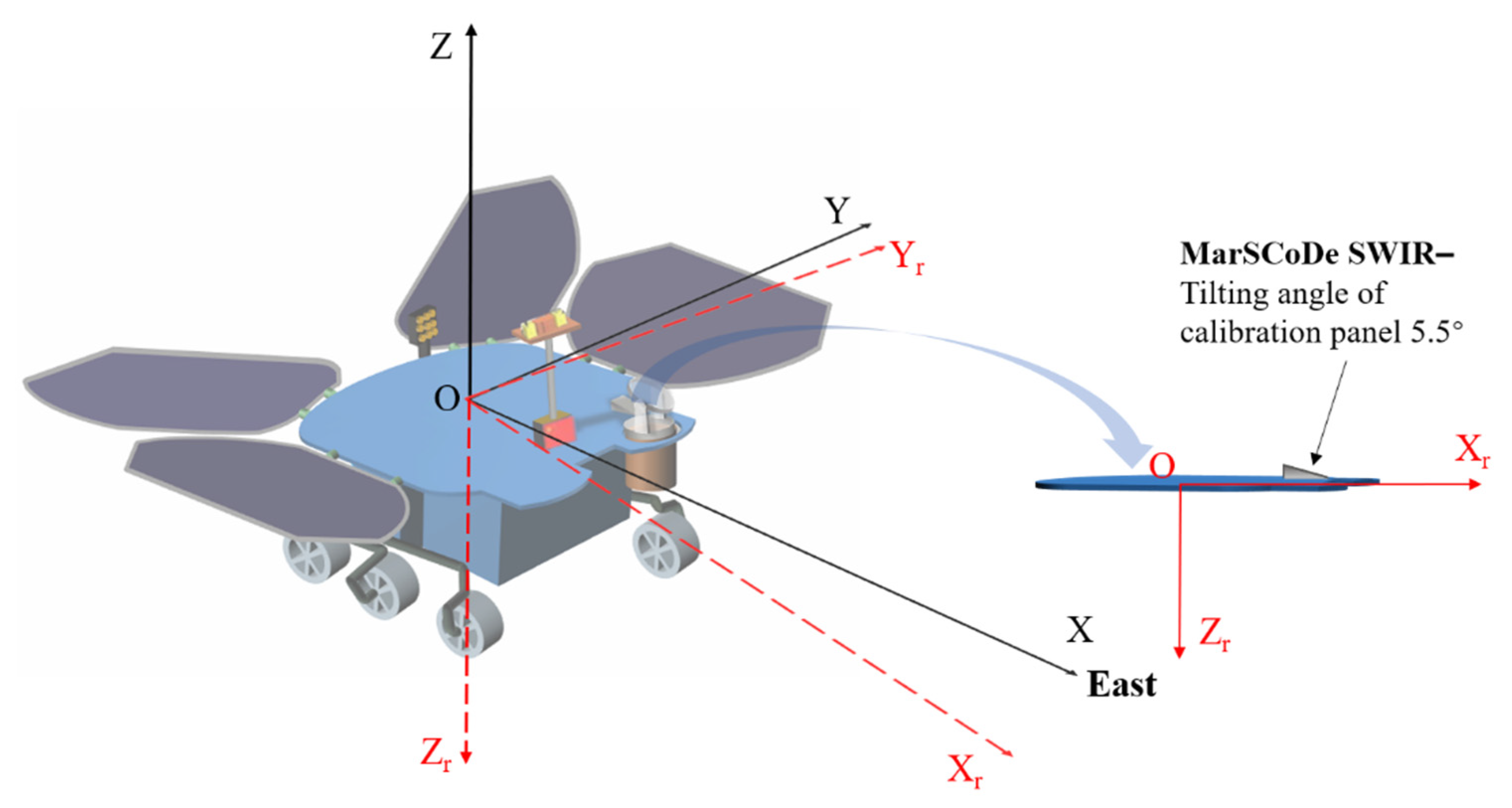
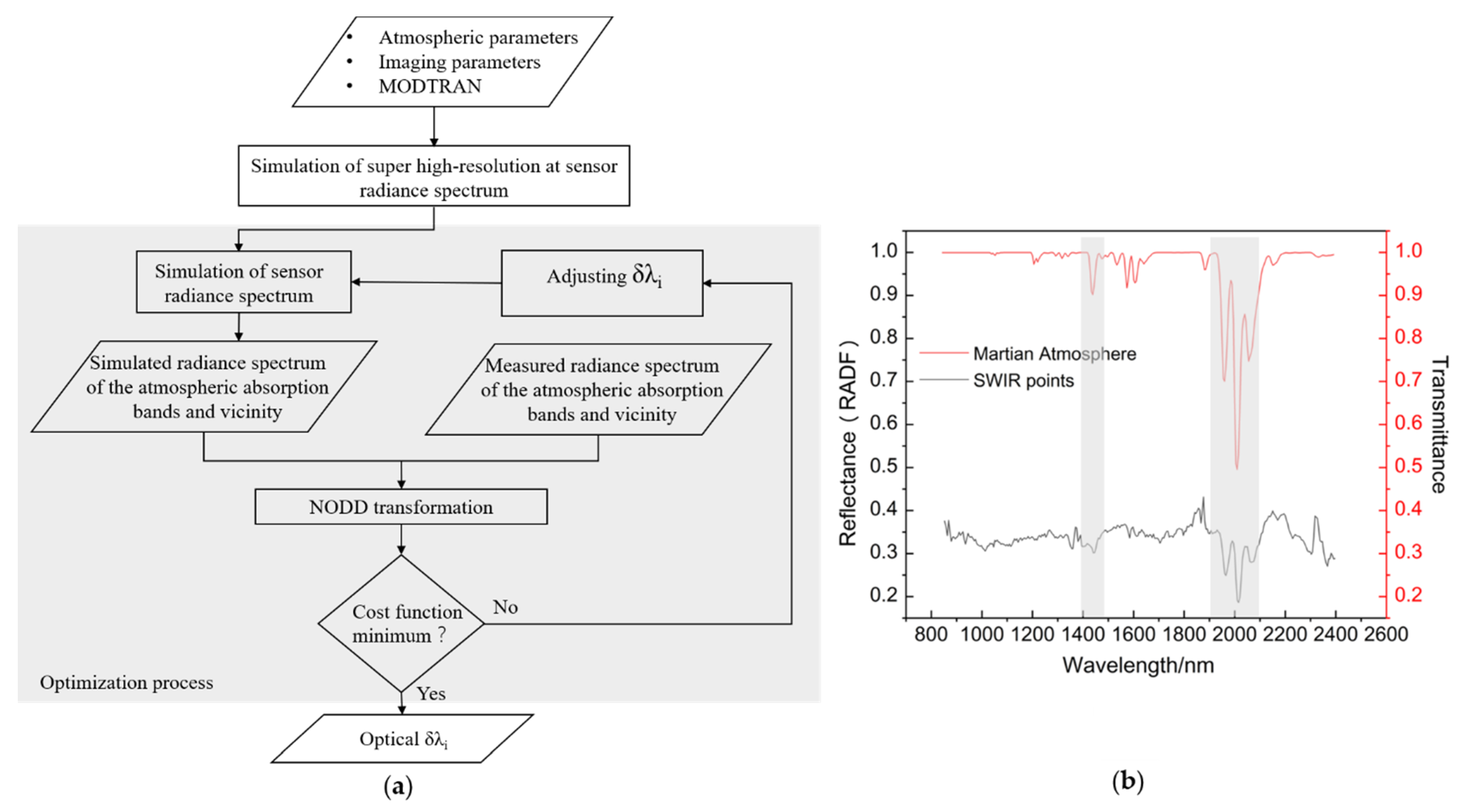

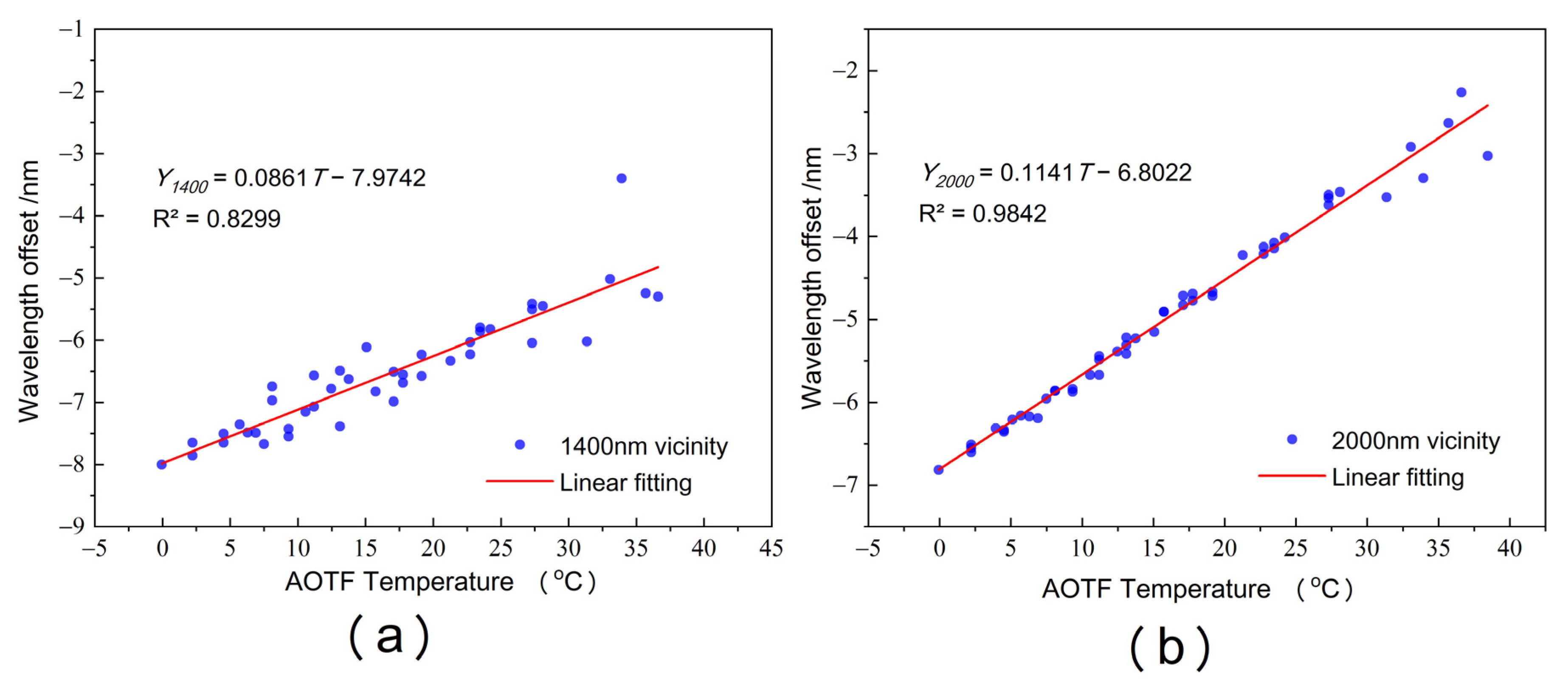
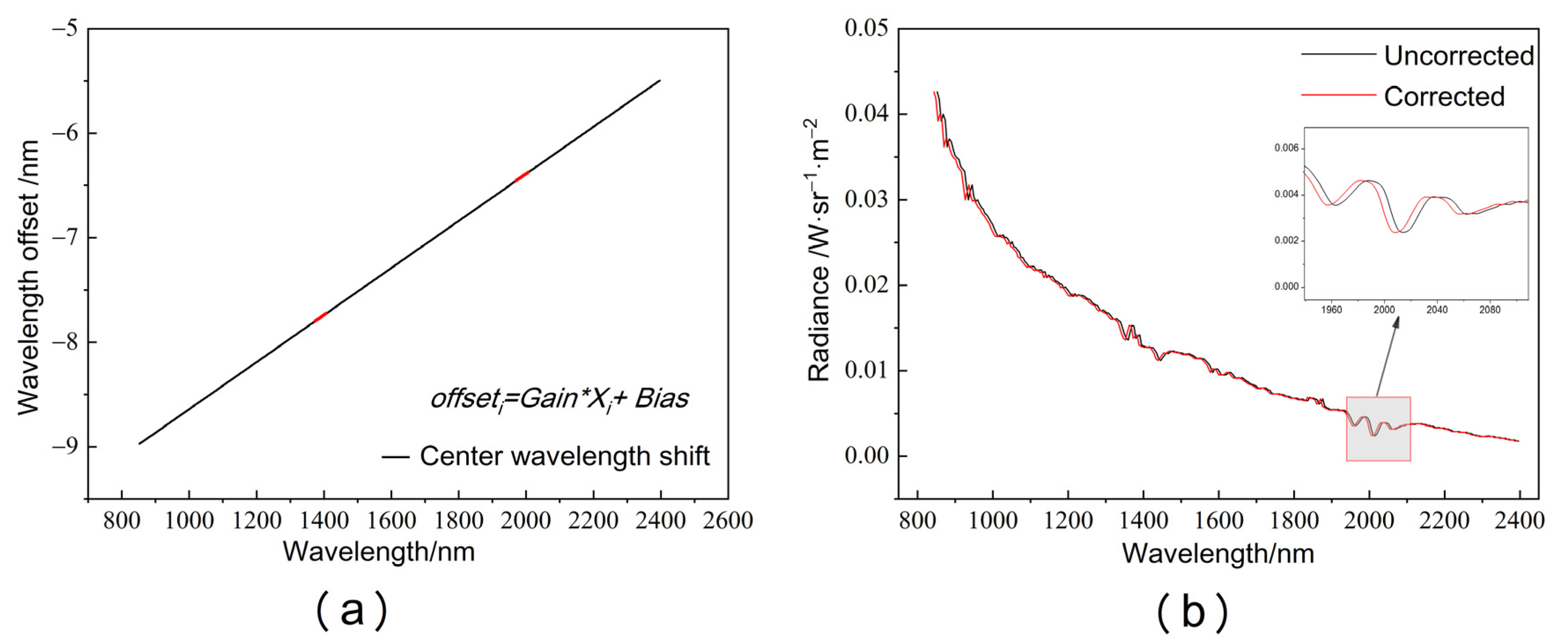
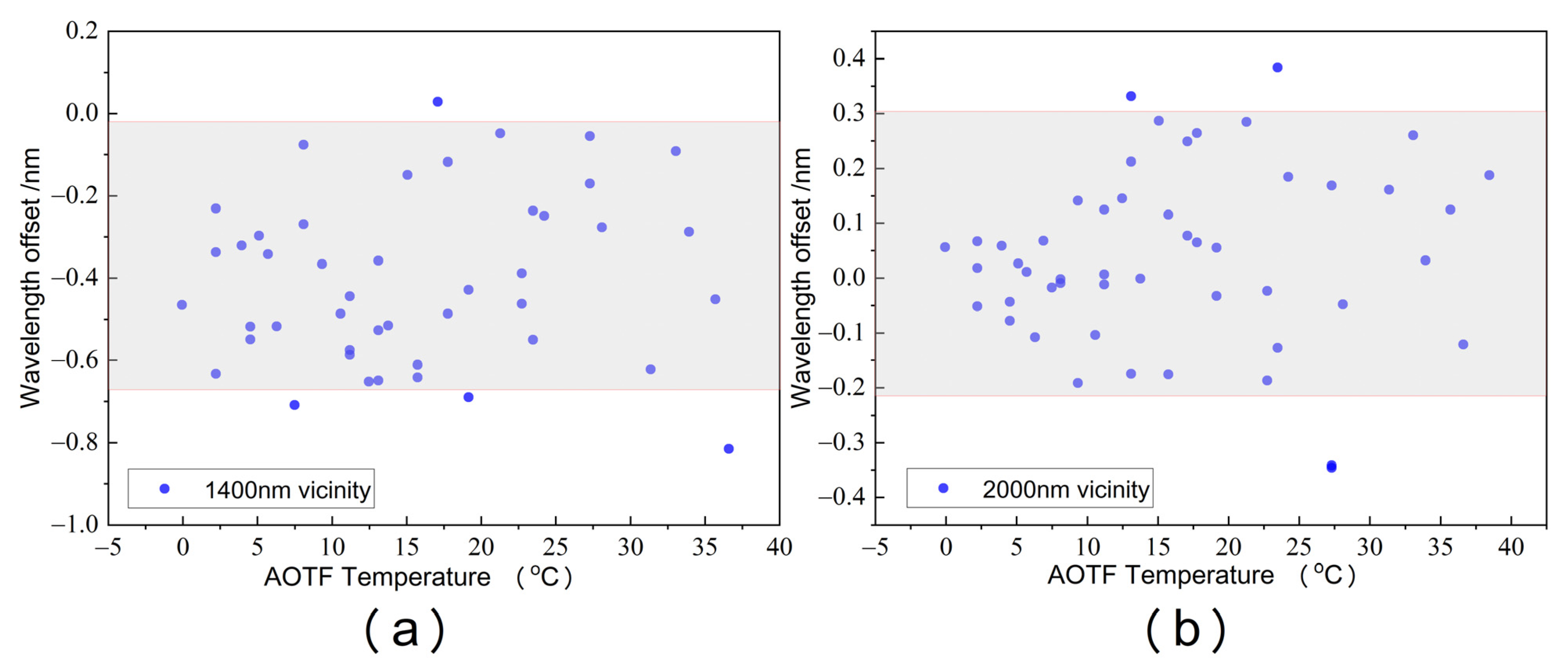


| SWIR spectrometer | Spectral range (nm) | 850–2400 |
| Spectral resolution (nm) | 3–12 | |
| Number of spectral bands | 321 band, 64 band @ 5 nm sample | |
| Field of view (mrad) | 36.5 | |
| Two-dimensional pointing mirror | Angle range | Pitch −21–199°, azimuth −59–32° |
| Pointing accuracy | Pitch 0.133°, azimuth 0.076° | |
| Pointing stability | Pitch 0.035°, azimuth 0.043° |
| Sol | Tilting (°) | Pitch (°) | Yaw (°) | Roll (°) | Incidence (°) | Azimuth (°) | N-Incidence (°) | N-Azimuth (°) |
|---|---|---|---|---|---|---|---|---|
| 32 | 5.5 | −2.011 | −96.345 | 177.00 | 4.760 | 138.881 | 5.846 | 94.952 |
| 41 | 5.5 | −1.643 | −116.253 | 179.26 | 51.203 | 279.370 | 48.044 | −102.598 |
| 43 | 5.5 | −0.143 | −157.740 | 179.43 | 17.325 | 94.570 | 22.500 | 22.123 |
| 45 | 5.5 | −1.362 | −145.649 | −179.50 | 66.578 | 285.199 | 61.932 | −127.964 |
| 47 | 5.5 | −0.341 | −125.114 | 179.74 | 17.257 | 93.417 | 20.963 | 46.503 |
| 50 | 5.5 | −0.335 | −84.298 | −179.98 | 66.446 | 285.630 | 68.232 | −66.478 |
| 58 | 5.5 | −1.132 | −80.645 | 178.16 | 23.906 | 87.697 | 24.530 | 89.231 |
| 65 | 5.5 | −0.846 | 2.285 | −178.50 | 14.795 | 269.902 | 19.484 | 5.930 |
| 69 | 5.5 | 0.214 | −101.569 | 178.72 | 14.771 | 270.752 | 14.519 | −84.701 |
| 79 | 5.5 | −0.747 | −82.776 | 178.12 | 14.731 | 272.452 | 15.247 | −67.029 |
| 87 | 5.5 | −1.198 | −106.530 | 179.93 | 14.715 | 273.360 | 13.360 | −79.987 |
| 92 | 5.5 | −0.291 | −88.209 | 179.14 | 4.654 | 271.892 | 6.595 | −41.689 |
| 100 | 5.5 | −0.445 | −106.816 | 179.21 | 2.848 | 86.820 | 6.726 | 29.743 |
| 103 | 5.5 | 0.346 | −57.121 | 179.96 | 4.320 | 87.397 | 4.873 | 44.581 |
| 110 | 5.5 | 2.093 | −45.277 | −177.93 | 4.986 | 88.274 | 6.196 | 35.726 |
Publisher’s Note: MDPI stays neutral with regard to jurisdictional claims in published maps and institutional affiliations. |
© 2022 by the authors. Licensee MDPI, Basel, Switzerland. This article is an open access article distributed under the terms and conditions of the Creative Commons Attribution (CC BY) license (https://creativecommons.org/licenses/by/4.0/).
Share and Cite
Wu, B.; Liu, C.; Xu, R.; Lin, H.; Xu, X.; Yan, W.; Tan, Y.; Liu, B.; Ren, X.; Xu, W.; et al. Initial In-Flight Spectral Calibration of the Near-Infrared Spectra Acquired by the MarSCoDe Onboard the Zhurong Rover. Remote Sens. 2022, 14, 2137. https://doi.org/10.3390/rs14092137
Wu B, Liu C, Xu R, Lin H, Xu X, Yan W, Tan Y, Liu B, Ren X, Xu W, et al. Initial In-Flight Spectral Calibration of the Near-Infrared Spectra Acquired by the MarSCoDe Onboard the Zhurong Rover. Remote Sensing. 2022; 14(9):2137. https://doi.org/10.3390/rs14092137
Chicago/Turabian StyleWu, Bing, Chengyu Liu, Rui Xu, Honglei Lin, Xuesen Xu, Wei Yan, Yongjian Tan, Bin Liu, Xin Ren, Weiming Xu, and et al. 2022. "Initial In-Flight Spectral Calibration of the Near-Infrared Spectra Acquired by the MarSCoDe Onboard the Zhurong Rover" Remote Sensing 14, no. 9: 2137. https://doi.org/10.3390/rs14092137






